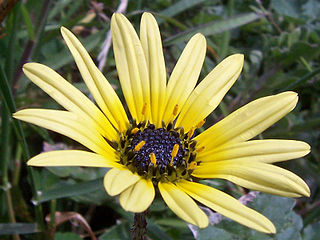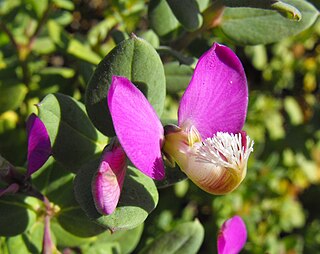
Psoralea is a genus in the legume family (Fabaceae) with 111 species of shrubs, trees, and herbs native to southern and eastern Africa, ranging from Kenya to South Africa. In South Africa they are commonly referred to as fountainbush (English); fonteinbos, bloukeur, or penwortel (Afrikaans); and umHlonishwa (Zulu).

Virgilia is a genus of Southern African trees in the family Fabaceae that is known for its very fast growth and a tendency to fall over as it matures. The common name in South Africa is keurboom, meaning 'choice tree'. Valued as useful ornamental trees by gardeners, the genus's two species are also known as tree-in-a-hurry, cape lilac, blossom tree and pink blossom tree.

Syncarpha is a genus of herbaceous flowering plants in the family Asteraceae. The flowers are known by the common name: everlastings. The genus is endemic to the fynbos of the Eastern and Western Cape in South Africa.

Lotononis is a genus of flowering plants in the family Fabaceae and the tribe Crotalarieae. The genus includes 99 species of annual and perennial herbs, native to the southeastern Europe and Turkey, eastern Africa, and southern Africa.

Phylica is a genus of plants in the family Rhamnaceae. It contains about 150 species, the majority of which are restricted to South Africa, where they form part of the fynbos. A few species occur in other parts of southern Africa, and on islands including Madagascar, the Mascarene Islands, Île Amsterdam, Saint Helena, Tristan da Cunha, and Gough Island. Phylica piloburmensis from the Burmese amber of Myanmar, dating to around 99 million years ago during the mid-Cretaceous, was originally described as the oldest fossil member of the genus, but subsequent studies contested its assignment to the genus Phylica and even to the family Rhamnaceae, with one study placing it in the separate genus Nothophylica.

Serruria, or spiderhead is a genus of flowering plants in the family Proteaceae, endemic to South Africa.

Arctotheca is a small genus of flowering plants in the family Asteraceae. They are annuals or perennials native to southern Africa. It is becoming an invasive weed in other parts of the world.
Lachnospermum, common name rooiblombos, is a genus of South African flowering plants in the family Asteraceae.

Plecostachys is a genus of South African flowering plants in the family Asteraceae. They are native to the Cape Provinces, KwaZulu-Natal, and Eswatini.

Diastella is a genus containing seven species of flowering plants, commonly known as “silkypuffs”, in the protea family. The name comes from the Greek diastellein “to separate”, with reference to the free perianth lobes – the plants are distinguished from the closely related and similar leucospermums by the possession of four free perianth segments. The genus is endemic to the Cape Floristic Region of South Africa where it has a very limited range and is associated with fynbos habitats. The species are all small shrubs. Most species are threatened.
Capeochloa is a genus of South African plants in the grass family. It contains three species of perennial grasses endemic to the Cape Provinces.
Diosma is a genus of flowering plants in the family Rutaceae, native to Cape Provinces of South Africa. The genus was first described by Carl Linnaeus in 1753.

Polygala fruticosa is a species of flowering plant in the milkwort family (Polygalaceae). It is native to Eswatini and Kwazulu-Natal and the Cape Provinces in South Africa. It was first described by Peter Jonas Bergius in 1767. According to the Red List of South African Plants, it is of least ecological concern.
The anthophytes are a grouping of plant taxa bearing flower-like reproductive structures. They were formerly thought to be a clade comprising plants bearing flower-like structures. The group contained the angiosperms - the extant flowering plants, such as roses and grasses - as well as the Gnetales and the extinct Bennettitales.
Globulariopsis is a genus of flowering plants belonging to the family Scrophulariaceae.
Melasma is a genus of flowering plants in the family Orobanchaceae. It includes seven species of herbaceous perennial plants native to the tropical Americas and sub-Saharan Africa, ranging from northeastern Mexico to northeastern Argentina and from the Democratic Republic of the Congo and Tanzania to South Africa.

Microdon is a genus of flowering plants in the family Scrophulariaceae. It includes seven species of subshrubs or shrubs native to the Cape Provinces of South Africa.










